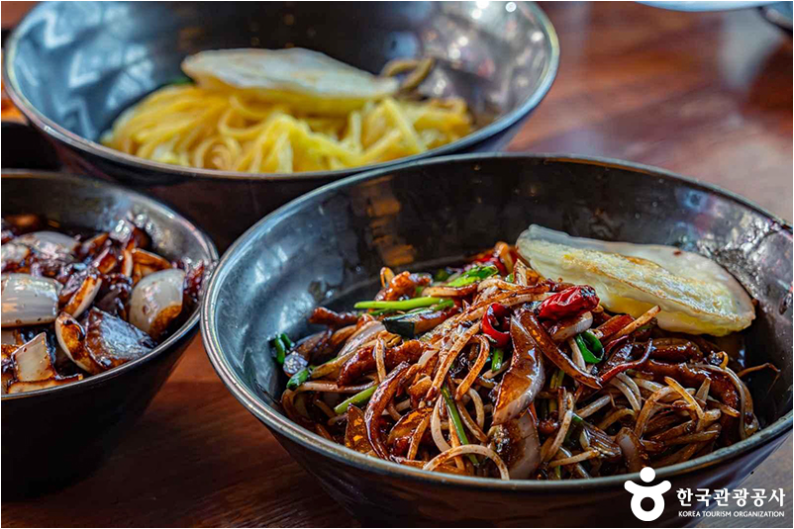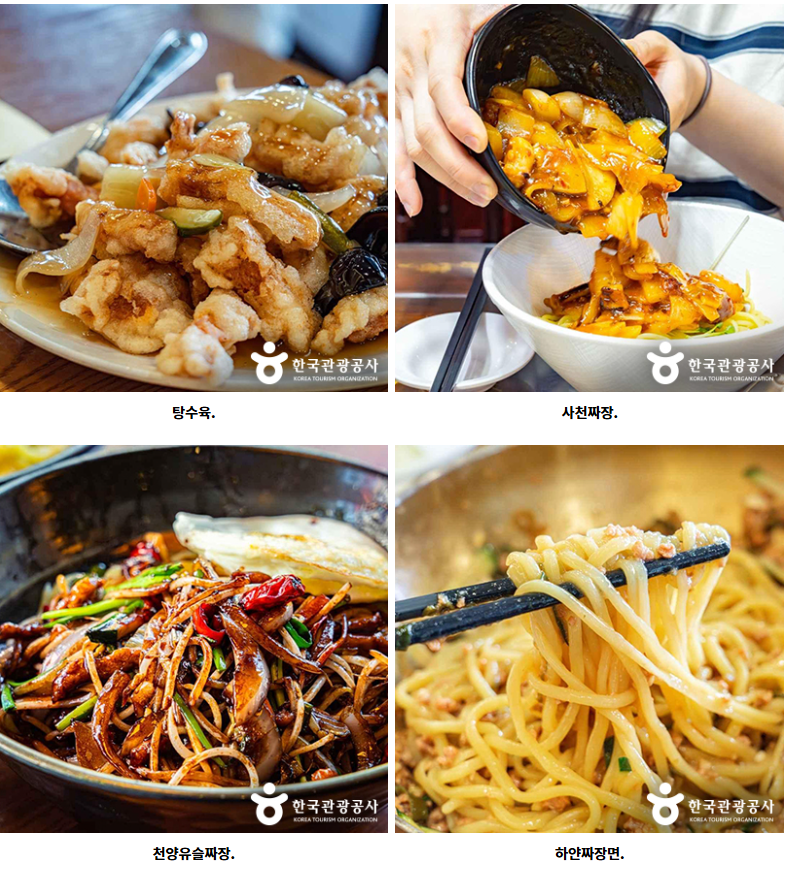Jjajangmyeon, a beloved Korean-Chinese fusion dish, represents more than just a meal. It reflects history, culture, and the evolution of culinary traditions in Korea. Let’s explore the origins, variations, and unique charm of this delectable dish, deeply rooted in Korean food culture.
The Origin of Jjajangmyeon: Born in Incheon’s Chinatown
Jjajangmyeon, derived from the Chinese dish Zhajiangmian (炸醬麵), first came to Korea in 1883 with the opening of Incheon Port. Chinese immigrants in the Qing-dominated concession area began cooking this noodle dish, which was later adapted to Korean tastes.
Initially, the sauce was made with fermented yellow soybean paste rather than the dark black chunjang (춘장) used today. The transformation of Jjajangmyeon into the dish we now know happened in the 1950s when caramel coloring was introduced, giving it the characteristic black sauce.
Incheon’s Chinatown remains the heart of Jjajangmyeon culture. A visit to this area offers a glimpse into its history and a chance to savor its authentic flavors. The Jjajangmyeon Museum, located in the historic Gonghwachun building, provides a deeper understanding of this iconic dish.

The Many Faces of Jjajangmyeon
While the original Jjajangmyeon was simple, it has since evolved into various styles, each offering a unique experience:
- Classic Jjajangmyeon: Features a pre-prepared, thick, savory sauce.
- Gan Jjajang (Dry Jjajang): Freshly cooked sauce with a more robust flavor, served separately from the noodles.
- Yuni Jjajang: Uses finely minced meat and vegetables for a smoother texture.
- Sichuan Jjajang: Spicy, inspired by the bold flavors of Sichuan cuisine.
- White Jjajang: Made with yellow soybean paste instead of black chunjang, offering a nostalgic and milder taste.
Personal Review: The rich, smoky flavor of Gan Jjajang is irresistible, while the bold spiciness of Sichuan Jjajang adds a delightful twist. Whether you prefer the classic or a modern variation, Jjajangmyeon always delivers!

A Must-Visit: Incheon Chinatown
Incheon Chinatown is the birthplace of Korean-style Jjajangmyeon. It’s home to numerous long-established Chinese-Korean restaurants, each offering their own twist on this classic dish. For a more traditional experience, try “white Jjajangmyeon,” a nostalgic nod to the dish's early days.
Additionally, you can enjoy a dual delight with Jjamjjamyeon, a combination of Jjajangmyeon and Jjamppong (spicy seafood noodle soup). It’s a perfect choice for those who can’t decide between the two.
Quick Recipes for Jjajangmyeon
[Classic Jjajangmyeon]
- Ingredients: Chunjang (125g), pork (150g), onion (130g), Chinese noodles (250g), cooking oil.
- Sauté diced pork in oil, then add onions.
- Mix in chunjang, season with sugar and salt.
- Boil the noodles and pour the sauce over them. Garnish with julienned cucumbers or a fried egg if desired.
[Gan Jjajang]
- Ingredients: Chunjang (125g), pork (150g), onion (130g), Chinese noodles (250g), garlic, soy sauce.
- Stir-fry chopped onions, pork, and garlic in hot oil.
- Add chunjang and season with soy sauce and sugar.
- Serve the sauce separately alongside freshly cooked noodles or rice.

Jjajangmyeon: A Culinary Icon of Korean Fusion
Jjajangmyeon is more than just food; it’s a reflection of Korea’s adaptability and creativity. Its affordability and comforting taste have made it a staple for Koreans, and its story adds depth to its deliciousness.
Whether you’re exploring Incheon’s Chinatown or recreating the dish at home, Jjajangmyeon is a journey through flavor and history you won’t want to miss.
'English > Korean Cuisine (K-Food)' 카테고리의 다른 글
| Budae Jjigae: A Taste of Korean Creativity and Resilience (0) | 2025.01.18 |
|---|---|
| Suwon King Galbi: A Timeless Korean Culinary Delight (0) | 2025.01.17 |
| Korean Soy Sauce Marinated Crab: A Unique Culinary Delight (0) | 2025.01.14 |
| Two Nutrient-Packed Winter Seafood Delights: Yellowtail and Trout (0) | 2025.01.13 |



